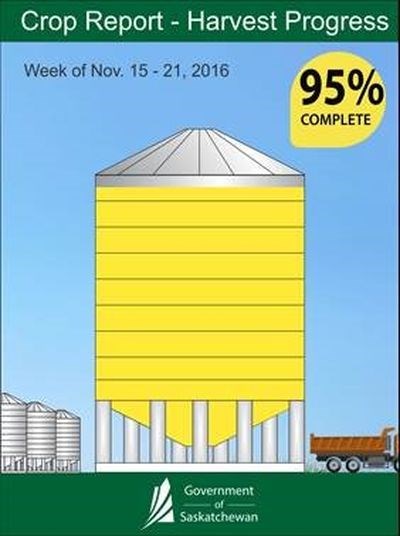聽 聽 聽 聽 聽 聽 Producers across the province are maintaining hope and optimism as many of them wrap of the harvest season and complete work for the year.
聽聽聽聽聽聽聽聽聽聽聽 Despite the challenges this fall brought, Saskatchewan producers now have 95 per cent of the crop combined, according to the Ministry of Agriculture鈥檚 crop report for November 15 to 21. Harvest is continuing in many parts of the province as weather and field conditions permit, and producers are hopeful that most of the remaining crop will be taken off prior to winter, and only a small amount will have to be left out until spring.
聽聽聽聽聽聽聽聽聽聽聽 Thanks to an increase in warm and relatively dry weather in early November, most producers returned to the field after October鈥檚 cool and wet conditions stalled harvest. While many producers have wrapped up harvest, some will need more time to take the crop off and some will have to wait for water-logged roads and fields to freeze before they are able to support harvest equipment.
聽聽聽聽聽聽聽聽聽聽聽 The west-central region has the most crop remaining in the field with only 89 per cent of the crop combined. The northeastern region has 91 per cent of the crop combined, the northwest has 95 per cent and the southeastern, southwestern and east-central regions each have 98 per cent combined.
聽聽聽聽聽聽聽聽聽聽聽 The dry weather has reduced moisture levels in some crops but most are still 小蓝视频 harvested tough and damp. Aeration bins and grain dryers are continually 小蓝视频 operated, and many farms have been running them for over a month.
聽聽聽聽聽聽聽聽聽聽聽 Yields for the majority of crops are far above average across the province. The crops and yields are: hard red spring wheat, 45 bushels per acre; durum, 48 bushels per acre; oats, 92 bushels per acre; barley, 69 bushels per acre; canola, 40 bushels per acre; peas, 42 bushels per acre, and lentils, 1,098 pounds per acre.
聽聽聽聽聽聽聽聽聽聽聽 Due to damage from insects, fusarium, diseases, sprouting, staining and bleaching, quality is below average for almost all crops.
聽聽聽聽聽聽聽聽聽聽聽 Average hay yields on dry land are 1.6 tons per acre for alfalfa; 1.7 tons per acre for alfalfa or brome; 1.4 tons per acre for other tame hay; 1.2 tons per acre for wild hay and 2.2 tons per acre for greenfeed. 聽Irrigated land has yielded three tons per acre for alfalfa, four tons per acre for alfalfa or brome and 4.5 tons per acre for wild hay and greenfeed.
聽聽聽聽聽聽聽聽聽聽聽 Going into winter, the hay quality is rated as 65 per cent good and 35 per cent fair with cattle producers indicating that they have adequate winter feed supplies.
聽聽聽聽聽聽聽聽聽聽聽 The number of acres seeded to winter cereals is slightly below average due to the late harvest and wet fields delaying fall seeding operations in much of the province.
聽聽聽聽聽聽聽聽聽聽聽 Cropland topsoil moisture conditions are rated as 51 per cent surplus and 49 per cent adequate, while hay land and pasture topsoil moisture conditions are rated as 24 per cent surplus, 75 per cent adequate and one per cent short.
聽聽聽聽聽聽聽聽聽聽聽 Farmers are busy trying to complete harvest by drying grain, finishing fall work and hauling grain. Many neighbours are assisting in the completion of harvest.
聽聽聽聽聽聽聽聽聽聽聽 Updates on the harvest may be found on the Ministry of Agriculture鈥檚 website or on Twitter at @SKAgriculture.




